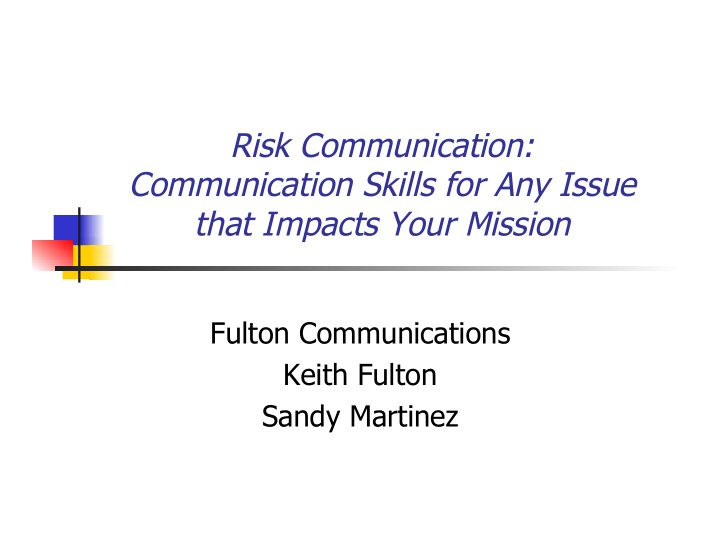



Risk Communication: Communication Skills for Any Issue that Impacts Your Mission Fulton Communications Keith Fulton Sandy Martinez
Topic One Risk Communication Overview Topic Outline � Learn what risk communication is. � Understand why risk communication is important. 1-1
What Is Risk Communication? Risk communication is communicating with any stakeholder, internal or external, on any issue that could impact your organization’s mission. 1-2
Know Your Stakeholder Gather sufficient intelligence about stakeholders that impact your mission Supporters � Straddlers � Splenetics �
The 3 Arenas of Risk Communication � Perception of Risk � Emotions such as � Anger � Fear � Agendas � Personal, economic, political, social, historical, and cultural 1-4
Why Do It? � Improved ability of the organization to focus on its mission � Get ahead of issues � Better relationships with stakeholders � Better risk management decisions � Improved court of public opinion judgments � Favorable outcomes from litigation 1-5
Risk Communication Skill Training Is Crucial � One communicator “misfiring” can affect the organization’s mission. � Risk communication is not public speaking or spinning messages. � It requires being open, honest, genuine, and sincere and applying the required communication skills (verbal and nonverbal) in a variety of situations. � Need to know how to deliver “bad news” – discuss uncertainties. 1-6
Communication Risk Factors Can Be Trumped By � Not knowing the stakeholders � Lack of transparency � Not admitting mistakes � Not getting in front of a problem � Not having the skills to handle anger and rudeness � Falling into the Risk Communication traps � Lacking non verbal observation skills 1-7
Topic Two Responding to Any Challenging Question or Statement Topic Outline � Learn two tools for responding to any challenging/ difficult question and/or statement from any stakeholder on any issue by using a combination of a Generic Categories Guideline. 2-1
Tool #1 Generic Categories of Questions and Statements This is a tool for how to start a response. � The next step will vary depending on their � reaction to your response. 2-2
Generic Categories of Questions and Statements Ventilation – anger 1. What’s the question or statement? 2. Rude but briefly acceptable 3. Negative allegations – not true 4. Negative allegations – true 5. Guarantee/100% assurance/no risk 6. acceptable 2-3
Generic Categories of Questions and Statements Fairness questions 7. The setup question or statement 8. Personal interest that’s not relevant (in group 9. discussions) 10. Policy 11. Factual questions – What? Who? When? Where? 12. Fear 2-4
Generic Category #3 Five Emotional Levels in Risk Communication Dialogue Physical threats � Unacceptable language or behavior � Rude but briefly acceptable � Difficult questions/statements � Factual dialogues (essentially no emotional � context) 2-5
Negative Emotions � Category #1 – Anger � Empathy � Open Ended Questions � Facts � Category #12 – Fear � Do know � Don’t know � Next update on “don’t knows” 2-6
Topic Three Communicating Risk Topic Outline � Learn tools and techniques helpful for on the job application of communicating risk. 3-1
Definition of Risk � Risk = Probability X Consequences � Risk = Stakeholder Perception = Stakeholder Reality � Unfortunately these 2 definitions are not always compatible. 3-2
Three Key Factors for the Risk Communication Arena of Risk Perception You usually need at least one of these factors if you want to improve stakeholder perception of risk. FAMILIARITY “CONTROL” BENEFITS 3-3
Third Party Support � Involve your supporters. This applies to internal and external stakeholders. � Find the stakeholders’ “Mother Theresa”. 3-4
Know How and When to Use Risk Comparisons � Risk comparisons can be effective in helping people better comprehend risk. � Avoid the trap of comparing voluntary risk to involuntary risk. � When in doubt about which risk comparison to use, ask your key stakeholders. 3-5
Know How and When to Use Numbers Some guidelines � Be aware of the numerator effect. � Relate numbers to something FAMILIAR to them. � Try to avoid negative terms, e.g., death per “X”. � When in doubt about which way to express numbers, ask your key stakeholders or, for internal communication, your knowledgeable employees. 3-9
Preemptive Strikes Get Out in Front � If you know a difficult item is going to come up, sometimes it’s best to bring “it” up first. � This avoids the perception that you were hoping to avoid it or “hiding it.” 3-10
Traps to Avoid � Humor � Negatives � Hedges � Jargon � Facts before conclusions � “Push Back” Statements 3-11
Traps to Avoid � Forgetting to apply your non verbal observation skills � Are they listening to your factual discussion � Do they seem confused? Tuned out? Irritated? � Afraid to say “I don’t know” � Taking it personally � Defensiveness � Verbal attacks � Feeling like a victim 3-12
Summary � These are some of the many skills required. � Pick the skills that fit your needs. 3-10
Recommend
More recommend